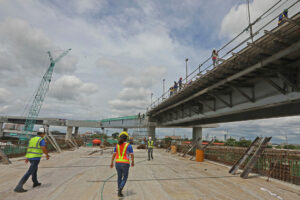Infrastructure spending surges 66% in August

STATE INFRASTRUCTURE spending surged by 65.8% in August as the government ramped up the implementation of projects, the Department of Budget and Management (DBM) said.
In its latest National Government (NG) disbursement report, the DBM said infrastructure and other capital outlays jumped to P122.1 billion in August from P73.7 billion in the same month a year ago.
Month on month, infrastructure spending also rose by 10% from P111 billion in July.
“This was largely attributed to the disbursements made by the Department of Public Works and Highways (DPWH) for its completed projects nationwide, such as national roads and bridges, infrastructure projects, flood control projects, convergence programs, and payment of right-of-way claims,” the DBM said.
Capital expenditures for the month also included the health facilities enhancement program of the Department of Health.
The DBM also cited payments made by development partners for the Department of Transportation’s (DoTr) railway projects, such as the Malolos-Clark Railway Project and the South Commuter Railway Project.
“The increase, however, was partly tempered by lower capital outlay disbursements posted in the Department of National Defense, largely due to the timing of releases for their Revised Armed Forces of the Philippines Modernization Program (RAFPMP),” the DBM said.
It noted that “big-ticket releases” are scheduled for the fourth quarter this year, unlike last year when significant disbursements were made in August.
In the first eight months, infrastructure spending climbed by 19.2% to P740.3 billion from P621.2 billion a year ago.
The Budget department attributed this to DPWH’s “robust spending performance.” It cited the accelerated project implementation for roads and bridges, closer monitoring of construction work, and expedited processing of billings by implementing offices.
“The direct payments made by foreign creditors of the DoTr for their foreign-assisted rail transport projects also contributed to the higher infrastructure and other capital outlays for the period,” the DBM added.
Meanwhile, infrastructure disbursements in the January-August period went up by 12.1% to P876.6 billion from P781.7 billion a year earlier.
These included estimated NG infrastructure disbursements and infrastructure components of subsidy and equity to government-owned and -controlled corporations and transfers to local government units.
Rizal Commercial Banking Corp. Chief Economist Michael L. Ricafort said in a Viber message that the higher infrastructure spending was due to the “commitment to ramp up government spending for the rest of 2023 after some underspending earlier this year to help support faster economic growth and recovery.”
“Furthermore, the base effects were already lower after the election-related spending earlier in 2022, thereby mathematically leading to faster year-on-year growth,” Mr. Ricafort added.
The Philippines’ gross domestic product (GDP) grew by 4.3% in the second quarter, the slowest in over two years. This was partially attributed to slow state spending, which contracted by 7.1%.
Government agencies have been tasked to come up with catch-up spending plans amid the low budget utilization in the first half.
The Department of Finance earlier said it is working with agencies to address challenges to spending, including procurement, implementation and payment issues.
This year, the government plans to spend 5.3% of GDP on infrastructure, equivalent to P1.29 trillion. — Luisa Maria Jacinta C. Jocson




